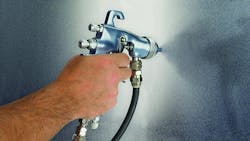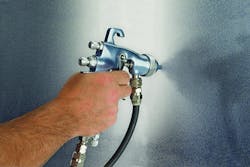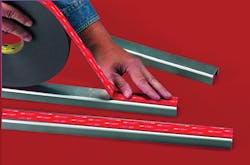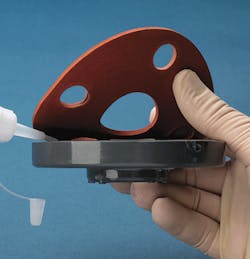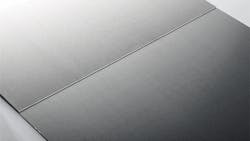Trends in Adhesives: Replacing Mechanical Fasteners
This file type includes high resolution graphics and schematics when applicable.
A long list of adhesives has been developed to meet and exceed engineers’ process and performance needs, including assembly and processing speed, and product durability and aesthetics. They can also be customized to provide a mix of benefits. For example, adhesives can be formulated with a range of different viscosities and even made into tapes and films.
Adhesives, like mechanical fasteners, are easy to apply or install manually. And like mechanical screws and rivets, applying adhesives can also be automated. This is a growing trend as engineers across industry lines are always looking to lower production and labor costs and increase quality and consistency. Even the application of two-part adhesives can be automated using specially designed cartridges. These cartridges use dispensing applicators and static mix nozzles to ensure the adhesives are precisely and thoroughly mixed in exact ratios at the touch of a button.
Other advances continue to be made in developing adhesives based on specific industry trends and demands. For example, low-odor adhesives fill a need for safer and more comfortable work environments. Adhesives that do not use volatile organic solvents have been formulated to meet environmental and sustainability initiatives. With design factors in mind, using adhesives can replace rivets and weld lines, and enable lightweight and cost efficient designs.
Bonding Dissimilar Materials and Composites
Materials with different coefficients of thermal expansion (CTEs) contract and expand differently under temperature variations. Mechanical fasteners do not allow expansion or contraction of joined materials during temperature variations without causing damage or unsightly bulging. But some adhesives have the flexibility to accommodate movements caused by thermal expansion of the substrates even after they have fully cured. As a plus, applying adhesives does not require putting holes in metal parts that may have protective coatings or paint. This means the metal underneath the layer of adhesive stays protected from the elements. In this way, adhesives prevent damage induced by thermal expansion and maintain protective coatings on materials, lengthening the life of the joint and product.
Mechanical fasteners, including rivets and bolts, are far from ideal for joining composites, as drilling holes can damage them and lead to money and time being wasted on repairs or replacements. Furthermore, drilling holes in composites causes the load-bearing stress to be concentrated entirely at the fastening point, which can lead to early failure. An adhesive bond transfers the load over the whole joint area, therefore distributing the load-bearing stress evenly throughout.
Using mechanical fasteners for these dissimilar materials and composites, as well as other projects, can limit engineers’ options in choosing materials or require them to increase material thickness. Adhesives, on the other hand, let engineers choose thinner and lighter materials. For example, SMC, plastics, or thinner-gauged aluminum or steel can be substituted in components where steel has been traditionally used in cowlings or enclosures. This reduces material costs and opens up manufacturing options not available when restricted to using thick materials.
Adhesives also work to lower costs by increasing productivity and efficiency during assembly. With adhesives, there is no grinding off weld marks, adding sealant to make the design waterproof, or straightening warped pieces, so throughput becomes faster.
Bonding materials often requires extensive surface preparation, especially when one or more of the materials is oily or has low surface energy. In cases like this, special adhesives including polypropylene, polyethylene, thermoplastic polyolefin (TPO), polyetrafluoroethylene (PTFE), polybutylene terephthalate (PBT), polystyrene, ethylene propylene diene monomer (EPDM) rubber and silicone can fit the bill. These adhesives accommodate hard-to-bond materials, so engineers can eliminate or drastically reduce tedious surface preparation steps by choosing the correct adhesive for the substrate. Hard-to-bond surfaces will require testing to find the best adhesive and application method, so the best route is to work with an adhesive supplier to determine the best product for the project at hand.
Adhesives and the Challenges of Lightweighting
The push to take the weight out of a product, a process called “lightweighting,” usually stems from the need to reduce the product’s energy consumption, decrease manufacturing costs, reduce the product’s size to improve portability, aesthetics, or user convenience, or some combination of these three goals. Engineers frequently encounter several design challenges when lightweighting products fastened together with adhesives. These challenges include:
Bonding to lighter substrates. Generally, when engineers decide to use a lighter-weight substrate, adhesion becomes more difficult. This can happen when changing from steel to aluminum in light-duty trailers; from aluminum to engineering plastic in small appliances; or from engineering plastic to polyethylene or propylene in a housing. Although it may not be possible to use the same adhesive on a lighter substrate, a range of other adhesives are available for almost any material combination.
Bonding dissimilar substrates. Attaching two pieces of the same substrate, such as steel to steel, is not a problem. However, joining dissimilar substrates can be formidable due to the differences in their chemical properties. For instance, if steel and aluminum are directly attached, an electrochemical reaction will corrode both metals. Adhesive tapes, such as those used to attach steel panels to aluminum posts in trailers, provide both separation of dissimilar substrates and adhesion.
Noisier substrates. Lightweight substrates usually generate produce more vibrations, which creates noise of greater frequency (i.e., more vibrations per second) and higher pitch. This noise can create perceptions of lower quality or decreased safety, for example, in the doors of cars and trucks. There are materials such that can be used for sound damping that decrease excessive frequency and pitch, improving users’ perception of product quality.
Weaker, more flexible substrates. Lighter substrates can be more flexible but weaker, so some products may need reinforcement to increase their strength and durability. However, the reinforcing materials must be light enough to lower the overall weight of the final product. There are adhesives such as tapes that can be used to strengthen product while keeping weight low.
Heat and flame susceptibility of substrates. Heat and flame resistance are critical for products as diverse as hair dryers, vacuums, snowmobiles and battery cables. Some applications may require overall heat resistance while others need one-time protection from flames at the end of product life. If a new substrate is susceptible to heat or flame, foil tapes can provide the necessary protection.
Visual appearance of substrates. Changing to lighter weight substrates, especially from metal to plastic, can significantly change the appearance of products and create the perception of reduced quality. However, this can be addressed by bonding veneers to the new substrates or products to enhance their aesthetics and consumer appeal.
Issues When Switching
When selecting an adhesive to replace one or more types of mechanical fasteners, it’s important to address the following issues:
Assembly: What type of assembly is required? It could be a simple as attaching trim or a gasket, mounting panels to framework, or full surface lamination.
Substrate: What materials to be assembled? For example, joining dissimilar materials may require a more flexible adhesive to accommodate differences in movement or thermal expansion.
Process: How can adhesives or tapes be used in manufacturing processes? This could be manual or automated assembly depending upon part sizes, volume, and other factors.
End-use: How and where will the final product be used? For example, there may be environmental requirements for the assembly like extreme temperature, UV, or chemical resistance.
Cost: Can money-saving improvements be made in the assembly process? Using adhesives and tapes often reduces labor, process steps, or lets less expensive materials be used.
Transitioning from mechanical fasteners to adhesives often comes with a qualification period for engineers because they will need to test different types of adhesives with varying qualities and strengths to determine which is appropriate for the project. Choosing a supplier that will help narrow down adhesive options is a smart move because it can reduce the time and costs associated with this phase of the project.
From applications as large as mounting a highway sign to as small as attaching a golf club’s head to its shaft, adhesives are opening up doors for assembly projects in every industry. Because adhesives can differ so much in strength and purpose, it is imperative for an engineer to partner with the right supplier who can assist in these assembly challenges and provide insight on the best solutions. A good supplier will also give advice on testing protocol and perform screening tests, to help the engineer avoid incurring additional expense, or wasting money and time on adhesives that will not fit a particular project.
Brent White, Global Marketing Manager
Shari Loushin, Senior Technical Service Specialist, Structural Adhesives
Classifying Adhesives
Adhesives can be categorized in several different ways. These categories include form, strength, structural or non-structural, and pressure sensitive adhesives, and hybrids.
Form: Adhesives can supplied as liquids, pastes, tapes, films, and shaped solids. Each has characteristics to be considered for application effectiveness and efficiency. Liquids and pastes, for example, readily fill voids to improve mechanical adhesion. Many liquids can be sprayed to cover large areas.
Films and pressure sensitive tapes also offer advantages specific to their form. They provide uniform thickness throughout the joint and the adhesive is confined to the immediate bonding area. There is no dripping or overflow, and no wasted adhesive. They can also be die-cut into complex shapes to make it easier to bond complex parts or parts with narrow bonding surfaces.
Hot melts are supplied as solid sticks, cartridges, pellets, or similar shapes. Handling and storage is easy and neat.
Strength: Another classification for industrial applications is by relative strength. Generally, adhesives that bond through chemical reactions are stronger than those that bond through physical changes.
Structural adhesives: These adhesives bond the load-bearing parts of products. As a rule of thumb, structural strength adhesives reach a minimum of 1,000 psi overlap shear strength. They include epoxies, acrylics, urethanes, cyanoacrylates, and anaerobics.
Epoxy adhesives available in one- and two-part liquids and pastes provide the highest strength and elevated temperature resistance. Acrylic adhesives, also two-part liquids and pastes, bond to the widest variety of substrates including hard-to-bond plastics and oily metals creating strong bonds without the need for the surface preparation required for epoxies and urethanes.
Urethane adhesives are generally low-cost two-part liquids and pastes that cure quickly to an elastic bond and are ideal for applications requiring flexibility between dissimilar materials. Their high Impact resistance is a distinctive characteristic.
Cyanoacrylate adhesives are high strength liquid formulations known as instant adhesives. On rigid plastic, glass, metal, rubber, and other low porosity substrates, they harden in seconds through reaction with surface moisture.
Anaerobic adhesives are liquids that cure to a tough plastic in the absence of oxygen and in the presence of metal. Typical applications include threadlocking, retaining, gasketing, and sealing.
Non-structural adhesives: These create bonds that vary in strength from repositionable to being as strong as the substrate being bonded. The adhesives are typically less than 1,000 psi in overlap shear strength and bond materials in cushions, gaskets, insulation. They include hot melts, rubber, and contact bond adhesives.
Hot-melt adhesives melt and flow under heat to wet the substrates and quickly from bonds upon cooling. They can be formulated to have short set times, be sprayable formulas, or permanently have PSA properties. Applications range from sealing to bonding automotive interior trim.
Rubber adhesives are solvent- or water-based and solidify through evaporation of the carrier. They adhere to various substrates, can be applied using several different methods, and the bonds they create generally resist environmental factors.
Contact bond adhesives usually get rolled, brushed, or sprayed on the two surfaces being joined and left to dry. When the surfaces are pressed together, near ultimate bond strength is achieved.
Pressure-sensitive adhesives: These adhesives are almost always applied via tapes and they grip immediately to mating surfaces. Over time, the adhesive conforms to surface irregularities.
Hybrid adhesives: These materials combine properties of different types of adhesives. For example, curing hot melts are moisture-curing urethanes that apply like a hot melt adhesive but when cooled have bond strength on par with two-part structural adhesives. And reclosable fasteners combine adhesive and mechanical fastening principles.
This file type includes high resolution graphics and schematics when applicable.
